For enthusiasts seeking the Fastest Electric Dirt Bike experience without breaking the bank, the current market offers exciting options. We embarked on a comprehensive test of eight leading lightweight electric motorcycles (eMotos) priced under $5,000 to identify their strengths and weaknesses.
Our diverse team of Electric Cycle Rider (ECR) testers brought varied expertise to this evaluation. Dustin, a double A class enduro racer, provided a professional perspective, while Michael, a B class racer, offered insights from a competitive standpoint. Mike, with his downhill mountain bike racing background, assessed agility and handling, and Tucker, ECR’s founder, contributed his overall industry knowledge. Together, we subjected each bike to rigorous testing across diverse terrains, ranking them based on our combined experiences. The results provide a clear picture for anyone looking to invest in a high-performance, affordable electric dirt bike.
Meet the Contenders: 2024 Electric Dirt Bikes Tested
Our test lineup included these eight prominent lightweight electric dirt bikes:
- Beta Explorer
- Surron Lightbee X
- Talaria Sting R
- Rawrr Mantis
- E Ride Pro SS 2.0
- Stage 2 M1
- RFN Ares DLX Version 2.0
- 79Bike Falcon M
Our evaluation process involved standardized tests across critical performance metrics. We conducted drag races to assess acceleration and top speed, battery range tests to determine real-world endurance, and practical assessments of battery removal ease. Furthermore, we rigorously evaluated braking performance, suspension capabilities, weight, peak power output, and price point to provide a holistic comparison.
Power Play: Peak Power Rankings
When it comes to raw power, the RFN Ares DLX and Beta Explorer emerged as joint leaders, both boasting a peak power of 12.5kW. Closely following was the E Ride Pro SS 2.0, delivering 12kW peak and 5kW nominal power. At the other end of the spectrum, the Surron Lightbee X and Stage 2 M1 shared the lowest peak power rating, at 6kW peak and 3kW nominal. It’s crucial to consider that the E Ride Pro SS, Beta Explorer, and RFN Ares DLX models feature a turbo button, offering a temporary power boost. Therefore, analyzing nominal power alongside peak figures provides a more nuanced understanding of sustained performance.
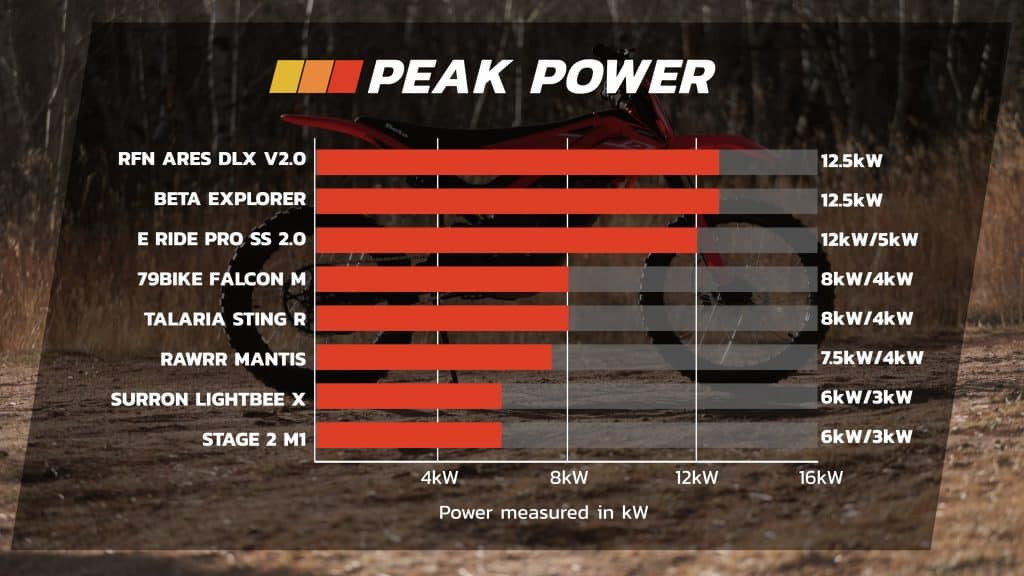 A detailed graph showcasing the peak power of various 2024 electric dirt bikes.
A detailed graph showcasing the peak power of various 2024 electric dirt bikes.
Drag Race Domination: Acceleration and Top Speed
Our drag race testing was designed to pinpoint the fastest electric dirt bike in terms of acceleration and top speed. We began with an initial group including the Beta Explorer, Surron Lightbee X, Talaria Sting R, and Rawrr Mantis. The Talaria Sting R quickly demonstrated superior speed in this group. Next, we pitted the Talaria Sting R against the RFN Ares DLX, E Ride Pro SS, and Stage 2 M1. The E Ride Pro SS decisively outpaced the competition, proving to be exceptionally quick. Finally, the 79Bike Falcon M joined the fray, racing against the Talaria Sting R. While the Falcon M secured a strong second place, the E Ride Pro SS remained unchallenged, solidifying its position as the ultimate winner in acceleration and top speed, and therefore, the fastest electric dirt bike in our test.
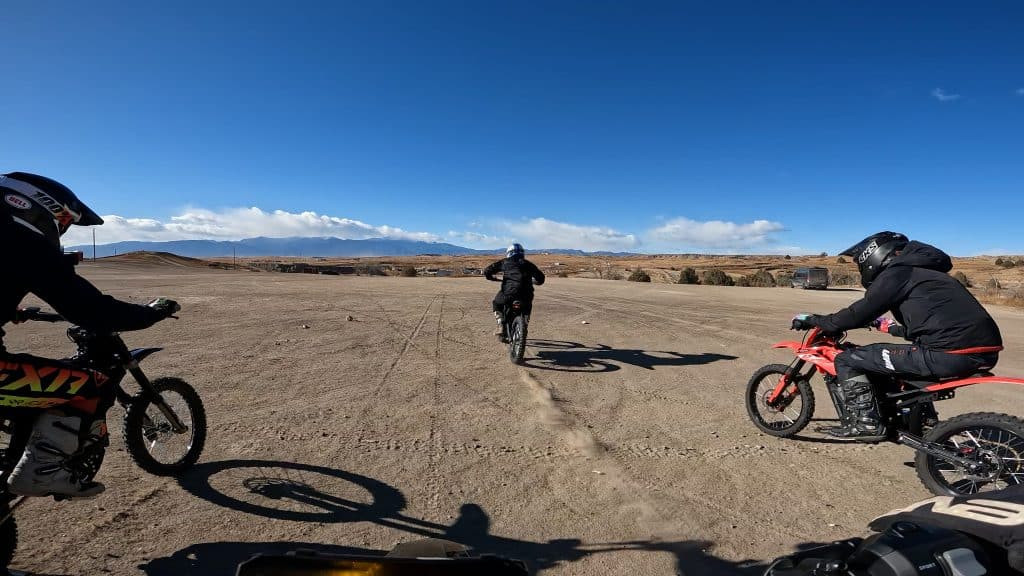 Electric dirt bikes participating in a drag race to determine the fastest model of 2024.
Electric dirt bikes participating in a drag race to determine the fastest model of 2024.
Battery Endurance: Capacity and Range Tests
To evaluate battery performance, we conducted range tests, riding each bike until approximately 15 percent battery capacity remained. In terms of battery capacity, the RFN Ares Rally DLX led with 3.2kWh, followed by the E Ride Pro SS with 2.9kWh. However, the E Ride Pro SS demonstrated the best range, achieving 25 miles per charge. The 79Bike Falcon M closely followed with 24 miles, and the RFN Ares DLX reached 23 miles. The Talaria Sting R managed 19 miles, the Surron Lightbee X 17 miles, the Beta Explorer 15 miles, the Rawrr Mantis 14 miles, and the Stage 2 M1 achieved 11 miles of range.
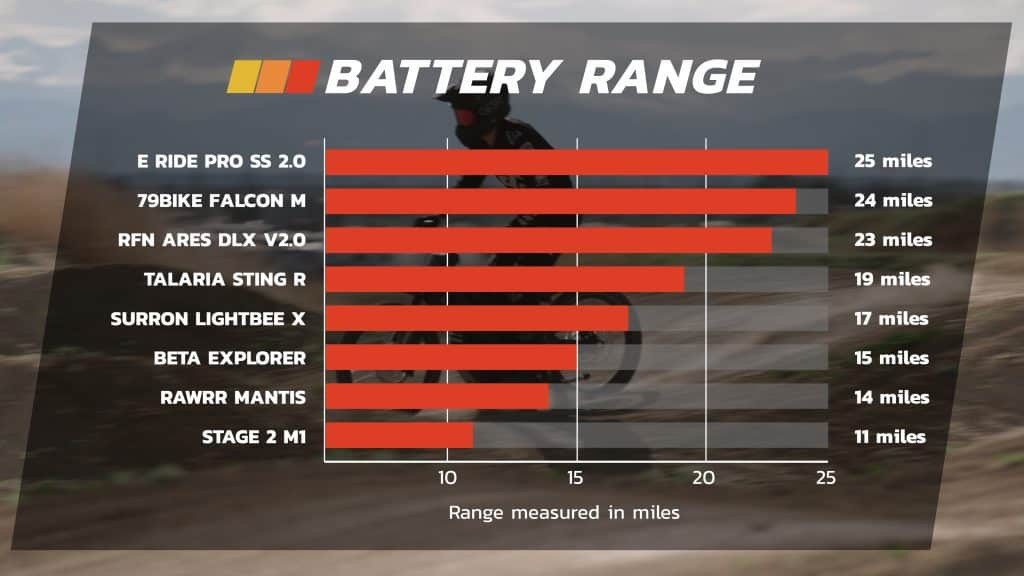 A visual comparison of battery range achieved by different 2024 electric dirt bikes.
A visual comparison of battery range achieved by different 2024 electric dirt bikes.
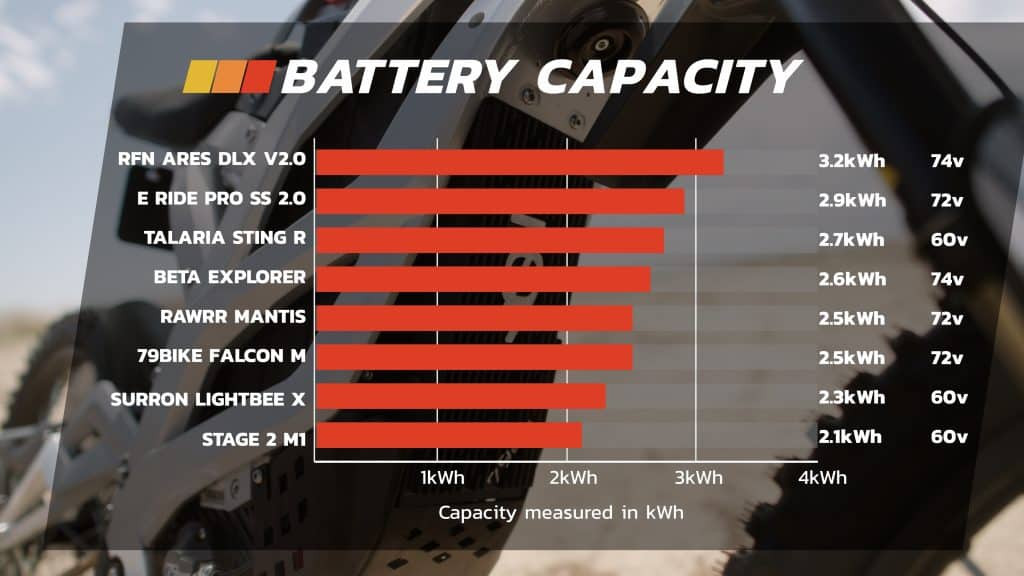 A chart displaying the battery capacity of various electric dirt bikes tested in 2024.
A chart displaying the battery capacity of various electric dirt bikes tested in 2024.
Battery Swap Convenience: Ease of Removal
We assessed the ease of battery removal, ranking the bikes from quickest and easiest to slowest and most challenging.
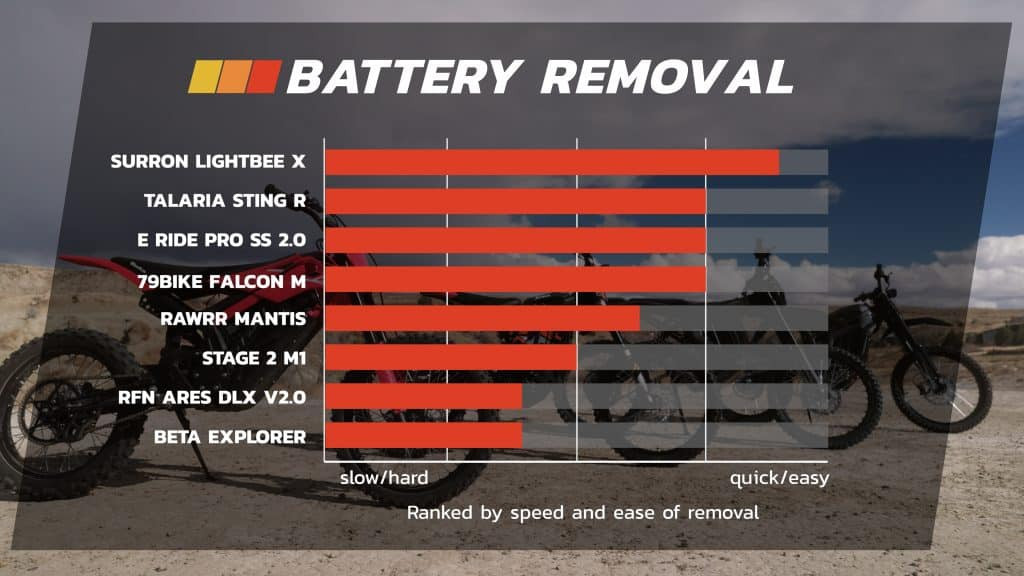 A comparison of battery swapping ease across different 2024 electric dirt bike models.
A comparison of battery swapping ease across different 2024 electric dirt bike models.
The Surron Lightbee X, Talaria Sting R, E Ride Pro SS, and 79Bike Falcon M share a similar battery compartment design. Despite the similar style, battery and compartment dimensions vary, leading to differing levels of removal difficulty. The Surron Lightbee X was deemed easiest, followed by the Talaria Sting R and E Ride Pro SS. The 79Bike Falcon M proved most challenging within this group due to its larger battery in a compact compartment. However, easier removal sometimes correlated with increased battery rattle, suggesting the need for shims to secure the battery.
The Rawrr Mantis features an automatic button for battery release, simplifying swaps, although the system’s reliance on battery connection was noted as a drawback. The Stage 2 M1’s full-size seat contributes to slower battery changes. The RFN Ares DLX and Beta Explorer share a complex battery removal system, with the Beta Explorer receiving a slight edge due to the RFN’s heavier battery.
Braking Performance: Stopping Power
The 79Bike Falcon M stood out with the best brakes by a significant margin. These brakes represent the highest performing stock brakes we’ve encountered on an eMoto. The E Ride Pro SS secured second place in braking performance, while the Rawrr Mantis ranked last in this category, indicating a considerable performance gap.
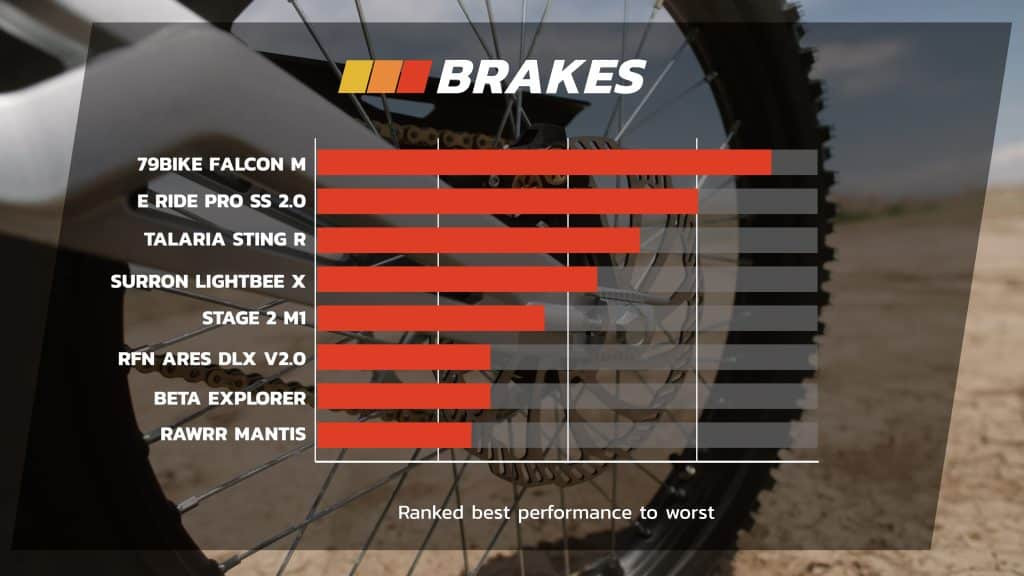 A visual representation of the braking performance of the 2024 electric dirt bikes tested.
A visual representation of the braking performance of the 2024 electric dirt bikes tested.
Weight Analysis: Lightest to Heaviest
In terms of weight, the Surron Lightbee X was the lightest bike in the test, weighing in at 123 pounds. The Rawrr Mantis was the heaviest at 165 pounds. The 79Bike Falcon M, despite housing a larger 72v battery, remained relatively light at 130 pounds.
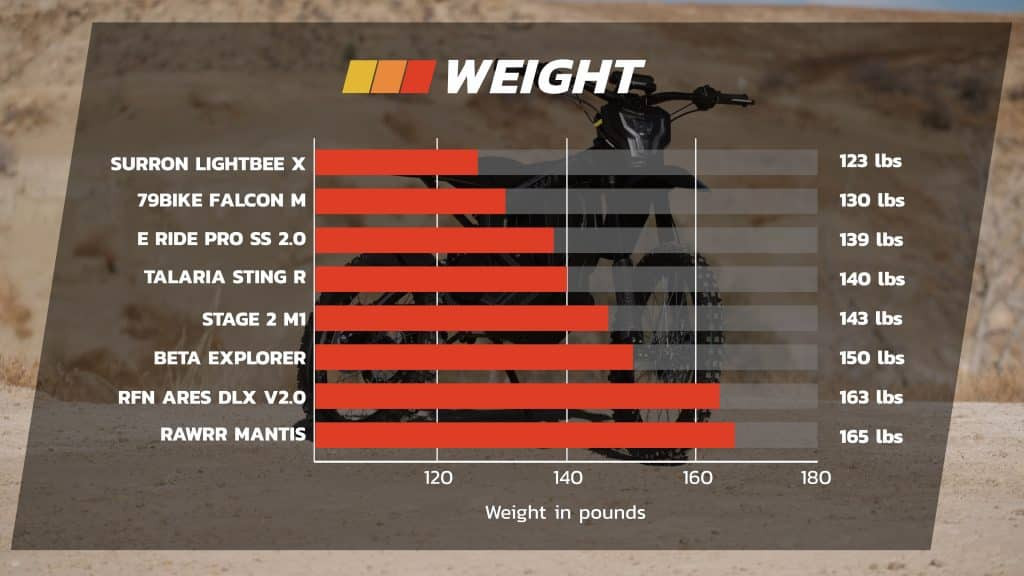 A weight comparison chart of the 2024 electric dirt bikes evaluated.
A weight comparison chart of the 2024 electric dirt bikes evaluated.
Suspension Dynamics: Handling and Comfort
The Talaria Sting R boasted the best suspension setup, a notable advantage. Our test bike featured a FastAce fork and shock, with some models offering the Talaria Factory fork, representing the most refined factory suspension in the group. The Surron Lightbee X surprised us with its runner-up suspension performance, an improvement over earlier models. The E Ride Pro SS suspension offered good support but lacked the compliance of the Sting R and Lightbee X.
The Stage 2 M1’s FastAce fork was commendable, but its linkage-less shock, while performing adequately, was a less desirable feature. The Beta Explorer and RFN Ares DLX offered decent suspension but lagged behind the leaders. The Rawrr Mantis suspension felt stiff and also utilized a linkage-less shock. The 79Bike Falcon M presented the least impressive suspension setup among the tested bikes.
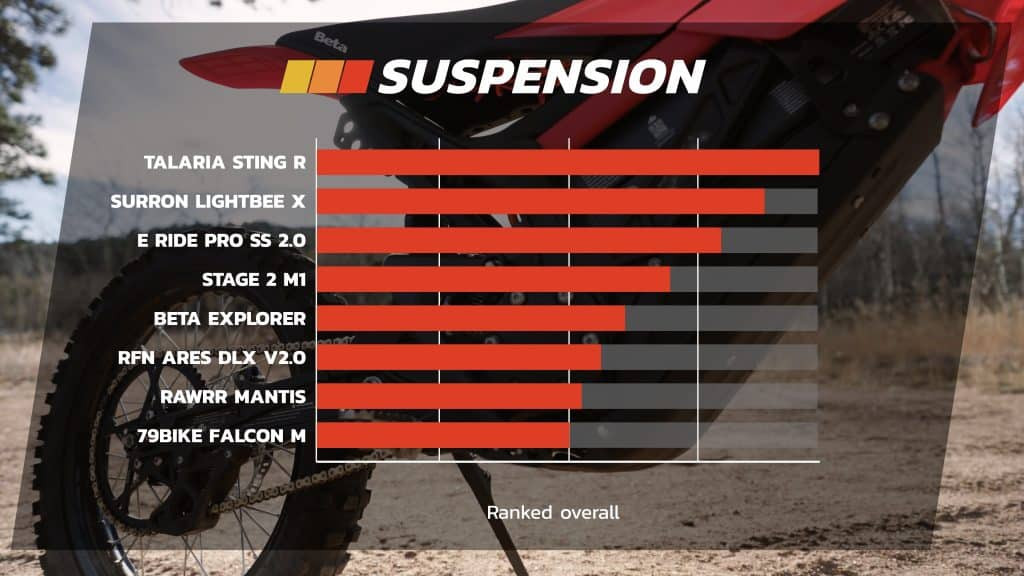 A graphic highlighting the suspension quality of different 2024 electric dirt bike models.
A graphic highlighting the suspension quality of different 2024 electric dirt bike models.
Price Point Comparison
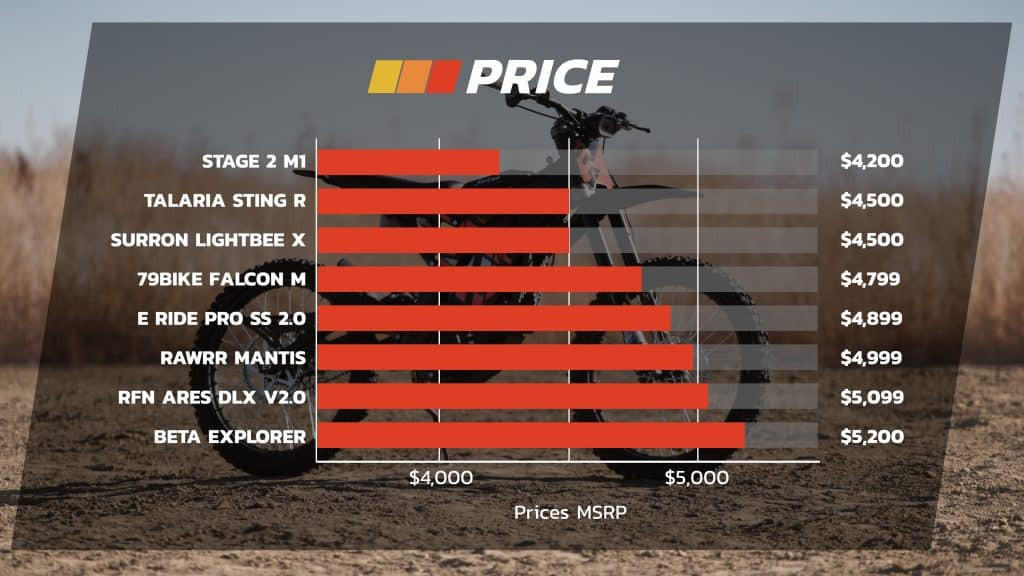 A price comparison table for the 2024 electric dirt bikes under review.
A price comparison table for the 2024 electric dirt bikes under review.
Prices may vary based on the point of purchase, but MSRP figures indicate the Stage 2 M1 as the most affordable at $4,200 and the Beta Explorer as the most expensive at $5,200.
Individual Bike Deep Dive: Pros and Cons
Beta Explorer
- Pros: Recognizable brand, extensive dealer network, appealing aesthetics, 18” rear wheel with Kenda tires.
- Cons: Inconvenient brake sensor disconnection, flexible swingarm, complex battery removal, low front end, limited power.
Surron Lightbee X
- Pros: Established dealer network, abundant aftermarket parts, well-suited for dirt jumps and BMX-style riding, improved suspension.
- Cons: Underpowered, outdated brakes and ergonomics, compact size may be uncomfortable for larger riders.
Rawrr Mantis
- Pros: Larger bike feel, adequate initial power delivery, firm suspension.
- Cons: Early power drop-off, weak brakes, stepped seat design.
Talaria Sting R
- Pros: Comfortable ergonomics, consistent power output, excellent suspension performance, numerous upgrade options.
- Cons: Battery rattle issue, small 44-tooth rear sprocket.
RFN Ares Rally DLX
- Pros: Extended rocket mode duration, upgraded tires, high-quality foot pegs, interchangeable headlight/number plate, reinforced swingarm.
- Cons: Low front end, unresponsive throttle, tendency to scrape pegs in ruts, limited power.
Stage 2 M1
- Pros: Comfortable riding position, good ergonomics, robust front fork.
- Cons: Slow overall speed, limited battery range, unusual handlebar bend, lacks battery percentage display.
E Ride Pro SS 2.0
- Pros: Fastest electric dirt bike in the test, highest top speed, good suspension support, desirable features.
- Cons: Sensitive front end, large display screen may be vulnerable to damage.
79Bike Falcon M
- Pros: Fast acceleration, powerful brakes, minimal battery rattle.
- Cons: Reports of stripped primary belts, clunky linkage noise, less capable suspension.
The Verdict: Crown for the Best Lightweight Electric Dirt Bike
The E Ride Pro SS Version 2.0 emerged as our unanimous top choice for the best lightweight electric dirt bike under $5,000 in 2024. Its exceptional speed and performance in drag races clearly marked it as the fastest electric dirt bike in our comparison. The Talaria Sting R secured a close second place, recognized for its superior suspension, comfortable ergonomics, and efficient transmission. Our team concluded that if the Talaria Sting R possessed the power of the E Ride Pro SS, it would have been the undisputed champion. Stay tuned for future content as we explore modifications to the Surron Lightbee X and Talaria Sting R, aiming to enhance their competitiveness against the E Ride Pro SS.
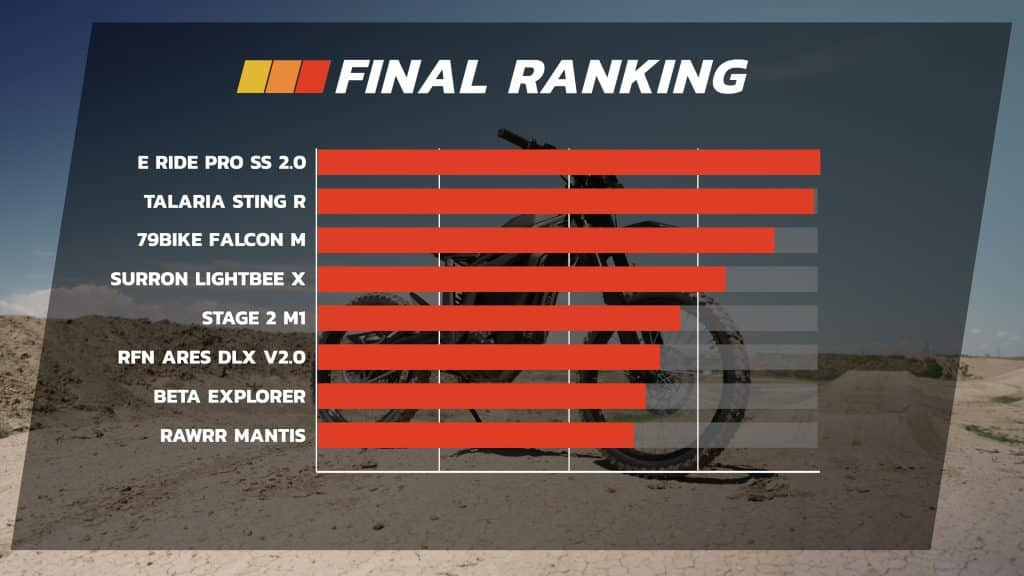 The top pick for the best lightweight electric dirt bike in 2024, as determined by testing.
The top pick for the best lightweight electric dirt bike in 2024, as determined by testing.
Final Ranking: Lightweight Electric Dirt Bikes (2024)
- E Ride Pro SS
- Talaria Sting R
- 79Bike Falcon M
- Surron Lightbee X
- Stage 2 M1
- RFN Ares Pro DLX
- Beta Explorer
- Rawrr Mantis
